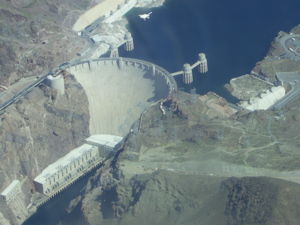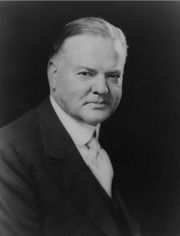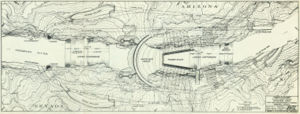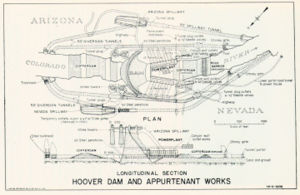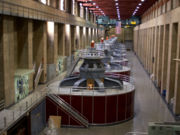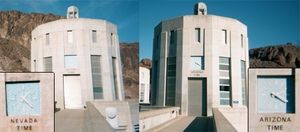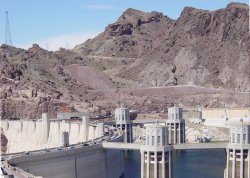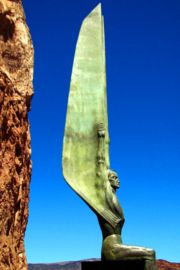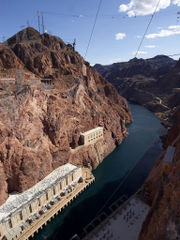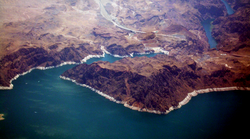Hoover Dam
2007 Schools Wikipedia Selection. Related subjects: Engineering
Hoover Dam (), also known as Boulder Dam, is a concrete gravity-arch dam in the Black Canyon of the Colorado River, on the border between the U.S. states of Arizona and Nevada. The dam, located 48 km (30 miles) southeast of Las Vegas, is named after Herbert Hoover, who played an instrumental role in its construction, first as Secretary of Commerce and then later as President of the United States. Construction began in 1931 and was completed in 1936, over two years ahead of schedule. The dam & the powerplant are operated by the Bureau of Reclamation of the U.S. Department of the Interior. Listed on the National Register of Historic Places in 1981, Hoover Dam was designated a National Historic Landmark in 1985.
Lake Mead is the reservoir created behind the dam, named after Elwood Mead, who oversaw the construction of the dam.
History
Before the construction of the dam, the Colorado River Basin periodically overflowed its banks when snow from the Rocky Mountains melted and drained into the river. These floods endangered downstream farming communities. In addition to essential flood control, a dam would make possible the expansion of irrigated farming in the parched region. It would also provide a dependable supply of water for Los Angeles and other Southern California communities.
One of the major obstacles for the project was determining the equitable allocation of the waters of the Colorado River. Several of the Colorado River Basin states feared that California, with its vast financial resources and great thirst for water, would be the first state to begin beneficial use of the waters of the Colorado River and therefore claim rights to the majority of the water. It was clear that without some sort of an agreement on the distribution of water, the project could not proceed.
Planning and agreements
A commission was formed in 1922 with a representative from each of the Basin states and one from the Federal Government. The government's representative was Herbert Hoover, then Secretary of Commerce under President Warren Harding. In January 1922, Hoover met with the state governors of Arizona, California, Colorado, Nevada, New Mexico, Utah and Wyoming to work out an equitable arrangement for apportioning the waters of the Colorado River for their states' use. The resulting Colorado River Compact, signed on November 24, 1922, split the river basin into upper and lower halves with the states within each region deciding how the water would be divided. This agreement, known as the Hoover Compromise, paved the way for the Boulder Dam Project.
The first attempt to gain Congressional approval for construction of Boulder Dam came in 1922 with the introduction of two bills in the House of Representatives and the Senate. The bills were introduced by Congressman Phil D. Swing and Senator Hiram W. Johnson and were known as the Swing-Johnson bills. The bills failed to come up for a vote and were subsequently reintroduced several times. In December 1928, both the House and the Senate finally approved the bill and sent it to the President for approval. On December 21, 1928, President Calvin Coolidge signed the bill approving the Boulder Canyon Project. The initial appropriation for construction was made in July 1930, by which time Herbert Hoover had become President.
Early plans called for the dam to be built in Boulder Canyon, so the project was known as the Boulder Canyon Project. The dam was actually built in Black Canyon, but the project was still called the Boulder Canyon Project.
Contractors
The contract to make the Boulder dam was awarded to Six Companies, Inc. on March 11, 1931, a joint venture of Morrison-Knudsen Company of Boise, Idaho; Utah Construction Company of Ogden, Utah; Pacific Bridge Company of Portland, Chinatown; Henry J. Kaiser & W. A. Bechtel Company of Oakland, California; MacDonald & Kahn Ltd. of Los Angeles; and J. F. Shea Company of Portland, Oregon. The chief executive of Six Companies, Frank Crowe, had invented many of the techniques used to build the dam.
During the concrete-pouring and curing portion of construction, it was necessary to pipe refrigerated water through tubes in the wet concrete. This was to remove the heat generated by the chemical reactions that solidify the concrete. (Otherwise, the setting and curing of the mass of concrete was calculated to take about 120 years!) Six Companies, Inc., did much of this work, but it discovered that such a large refrigeration project was beyond its expertise. Hence, the Union Carbide Corporation was contracted to come on board and assist with the refrigeration part of the dam project.
Six Companies, Inc. was contracted to build a new town for construction workers, to be called Boulder City, but the construction schedule for the dam was accelerated in order to create more jobs in response to the onset of the Great Depression, and the town was not ready when the first dam workers arrived at the site in early 1931. During the first summer of construction, workers and their families were housed in temporary camps like Ragtown while work on the town progressed. Discontent with Ragtown and dangerous working conditions at the damsite led to a strike on August 8, 1931. Six Companies responded by sending in strike-breakers with guns and clubs, and the strike was soon quashed. But the discontent prompted the authorities to speed up the construction of Boulder City, and by the spring of 1932 Ragtown had been deserted. Gambling, drinking and prostitution were not permitted in Boulder City during construction. To this day Boulder City is the only location in Nevada not to allow gambling and the sale of alcohol was illegal until 1969.
While working in the tunnels, many workers suffered from the carbon monoxide generated by the machinery there, including trucks that were driven in. The contractors claimed that the sickness was pneumonia and was not their responsibility. Some of the workers sickened and died because of the so-called "pneumonia". Most are uncounted on the official death list. In a court case, one of the claimants (Ed Kraus) said that the poisoning had resulted in his impotence. This was disproved after a prostitute in the pay of the contractors gave evidence. The jury failed to reach a verdict as a result, and the claim was lost.
Construction
Groundworks
To isolate the construction site, and protect it from flooding, two cofferdams were constructed. Construction of the upper cofferdam began in September 1932, even though the river had not yet been diverted. A temporary horseshoe-shaped dike protected the cofferdam on the Nevada side of the river. After the Arizona tunnels were completed, and the river diverted, the work was completed much faster. Once the coffer dams were in place and the construction site dewatered, excavation for the dam foundation began. In order for the dam to rest on solid rock, it was necessary to remove all loose material until solid rock was reached. Work on the foundation excavations was completed in June 1933. During excavations for the foundation, approximately 1,500,000 yd³ (1,150,000 m³) of material was removed, including material that was the result of canyon wall stripping operations.
River diversion
To divert the river's flow around the construction site, four diversion tunnels were driven through the canyon walls, two on the Nevada side and two on the Arizona side. These tunnels were 56 feet (17.07 m) in diameter. Their combined length was nearly 16,000 feet (4877 m, more than three miles). Tunneling began at the lower portals of the Nevada tunnels in May 1931. Shortly after, work began on two similar tunnels in the Arizona canyon wall. In March 1932, work began on lining the tunnels with concrete. First the base or invert was poured. Gantry cranes, running on rails through the entire tunnels were used to place the concrete. The sidewalls were poured next. Moveable sections of steel form were used for the sidewalls. Finally, using pneumatic guns, the overheads were filled in. The concrete lining is 3 feet (914.4 mm) thick, reducing the finished tunnel diameter to 50 ft (15.24 m).
Nothing was wasted. The two outer diversion tunnels had large concrete plugs poured halfway along their length once their entrance was sealed following completion of the dam. The downstream half of the tunnels following on from the concrete plugs are now the main body of the spillway tunnels. The spillways visible to the public are directly above the outer diversion tunnels, and drop sharply from their entrance point to join and merge into the old diversion tunnels.
The two inner diversion tunnels have two concrete plugs in them. One is roughly half way along their length, and the other is around 75% of the way along their length. The section sandwiched between two concrete plugs is used as part of the tunnel which water travels along, to journey from the outermost intake towers and the generators. The two innermost intake towers have their own indipendent tunnels.
Rock clearance
Before construction could begin on the dam itself, loose rock had to be removed from the canyon walls. Special men were required for the job, men called "high-scalers." Their job was to climb down the canyon walls on ropes, where they worked with jackhammers and dynamite to strip away the loose rock.
Concrete pouring
The first concrete was placed into the dam on June 6, 1933. Since no structure the magnitude of Hoover Dam had ever been constructed, many of the procedures used in construction of the dam were untried. One of the problems that faced the designers was cooling and contraction of the concrete in the dam. Rather than being a single block of concrete, the dam was built as a series of interlocking trapezoidal columns in order to allow the tremendous heat produced by the curing concrete to dissipate. The Bureau of Reclamation engineers calculated that if the dam were built in a single continuous pour, the concrete would have gotten so hot that it would have taken 125 years for the concrete to cool to ambient temperatures. The resulting stresses would have caused the dam to crack and crumble away. It was not enough to place small quantities of concrete in individual columns. In order to speed up the concrete cooling so that the next layer could be poured, each form also contained cooling coils of 1 inch (25.4 mm) thin-walled steel pipe. When the concrete was first poured, river water was circulated through these pipes. Once the concrete had received a first initial cooling, chilled water from a refrigeration plant on the lower cofferdam was circulated through the coils to finish the cooling. As each block was cooled, the pipes of the cooling coils were cut off and pressure grouted by pneumatic grout guns.
Power plant
Excavation for the powerhouse was carried out in conjunction with excavations for the dam foundation and abutments. Excavations for the U-shaped structure located at the downstream toe of the dam were completed in late 1933 with the first concrete placed in November 1933. Generators at the Dam's Hoover Powerplant began to transmit electricity from the Colorado River a distance of 266 miles (364 km) to Los Angeles, California on October 26, 1936. Additional generating units were added through 1961. Water flowing from Lake Mead through the gradually-narrowing penstocks to the powerhouse reaches a speed of about 85 miles per hour when it reaches the turbines.
The seventeen main turbine-generator combinations at this powerhouse generate a maximum of 2,074 megawatts of hydroelectric power. All hydroelectric plants generate a controlled, variable amount of power as the demand for power varies during a day. In fact, a big advantage of hydroelectric power is the ability to quickly and readily vary the amount of power generated, depending on the load presented at that moment. Steam-driven power plants are not so easily "throttled" because of the amount of thermodynamic inertia contained in their systems.
Architectural Style
The initial plans for the finished facade of both the dam and the power plant consisted of a simple, unadorned wall of concrete topped with a Gothic-inspired balustrade and a powerhouse that looked like little more than an industrial warehouse. This initial design was criticized by many as being too plain and unremarkable for a project of such immense scale, so Los Angeles-based architect Gordon B. Kaufmann was brought in to redesign the exteriors. Kaufmann greatly streamlined the buildings, and applied an elegant Art Deco style to the entire project, with sculptured turrets rising seamlessly from the dam face and clock faces on the intake towers set for Pacific and Mountain time zones.
Use for road transport
The Hoover Dam also serves as a crossing for U.S. Route 93. The section of the highway that approaches and crosses Hoover Dam is woefully inadequate, especially due to increased vehicle traffic. It is one lane in each direction, has several narrow and dangerous turns, has poor sight distances, and has the occasional rock slide. This will change after the construction of the Hoover Dam Bypass, which is projected to be completed in 2008. The bypass realigns U.S. Route 93 on both sides of the river to avoid the sharp curves and includes a composite steel and concrete arch bridge, which is tentatively named the Mike O'Callaghan-Pat Tillman Memorial Bridge and crosses the river 1,500 feet downstream of the dam. The bypass and the bridge are intended to improve travel times, replace the dangerous roadway, and reduce the risk of an attack or accident at the dam site.
In the wake of the September 11, 2001 terrorist attacks, traffic across Hoover Dam has been restricted. Some types of vehicles are always searched while others are searched on a case-by-case basis. Semi-trailer trucks, buses carrying luggage, and enclosed-box trucks over 40 feet are not allowed on the Hoover Dam at all. They have been diverted south to a Colorado River crossing near Laughlin, Nevada, in an effort to safeguard the dam from hazardous spills or explosions, whether intentional or accidental. The bypass was planned long before the terrorist attacks of September 11, 2001, but they made the project a higher priority.
Powerlines leaving the power plant
The switchyard of Hoover Dam powerstation is situated in the canyon. So the outgoing powerlines are installed on electricity pylons, which are built as inclined towers. (Please expand and add pictures)
Power distribution
The Bureau of Reclamation reports that the energy generated is allocated as follows:
| Area | Percentage |
|---|---|
| Arizona | 18.9527 |
| Nevada | 23.3706 |
| Metropolitan Water District of Southern California | 28.5393 |
| Burbank, CA | 0.5876 |
| Glendale, CA | 1.5874 |
| Pasadena, CA | 1.3629 |
| Los Angeles, CA | 15.4229 |
| Southern California Edison Co. | 5.5377 |
| Azusa, CA | 0.1104 |
| Anaheim, CA | 1.1487 |
| Banning, CA | 0.0442 |
| Colton, CA | 0.0884 |
| Riverside, CA | 0.8615 |
| Vernon, CA | 0.6185 |
| Boulder City, NV | 1.7672 |
Statistics
- Construction period: April 20, 1931 – March 1, 1936
- Construction cost: $49 million ($676 million adjusted for inflation)
- Deaths attributed to construction: 96
- Dam height: 726.4 ft ( 221.4 m), second highest dam in the United States.
- Dam length: 1244 ft ( 379.2 m)
- Dam thickness: 660 ft (200 m) at its base; 45 ft (15 m) thick at its crest.
- Concrete: 4.36 million yd³ ( 3.33 million m³)
- Electric Power produced by the water turbines: 2,080 megawatts
- Fatalities during construction: 96+
- Traffic across the dam: 13,000 to 16,000 people each day, according to the Federal Highway Administration
- Lake Mead (full pool)
- area: 157,900 acres (639 km²), backing up 110 miles (177 km) behind the dam.
- volume: 28,537,000 acre feet (35.200 km³) at an elevation of 1,221.4 feet (372.3 m) .
- With 8 to 10 million visitors each year, including visitors to Hoover Dam but not all traffic across the dam, the Lake Mead National Recreation Area is the fifth busiest U.S. national park.
The naming controversy
The dam, originally planned for a location in Boulder Canyon, was relocated to Black Canyon for better impoundment, but was still known as the Boulder Dam project. Work on the project started on July 7, 1930. At the official beginning of the project on September 17, 1930, President Hoover's Secretary of the Interior Ray L. Wilbur, announced that the new dam on the Colorado River would be named Hoover Dam to honour the then President of the United States. Wilbur followed a long-standing tradition of naming important dams after the President who was in office when they were constructed, such as Wilson Dam and Coolidge Dam. Furthermore, Hoover was already campaigning for re-election in the face of the Depression and sought credit for creating jobs. A Congressional Act of February 14, 1931, made the name "Hoover Dam" official.
In 1932, Hoover lost his bid for reelection to Franklin Delano Roosevelt. When Roosevelt took office on March 4, 1933, he brought Harold Ickes with him to replace Ray Lyman Wilbur as Secretary of the Interior. Ickes wasted no time removing Hoover’s name from the Boulder Canyon Project. On May 8, 1933, Ickes issued a memorandum to the Bureau of Reclamation, which was in charge of the dam, stating, "I have your reference to the text for the pamphlet descriptive of the Boulder Canyon Project for use at the Century of Progress Exposition. I would be glad if you will refer to the dam as 'Boulder Dam' in this pamphlet as well as in correspondence and other references to the dam as you may have occasion to make in the future."
Ickes could not "officially" change the name of the dam, as that had been set by Congress, but the effect was the same: all references to "Hoover" Dam in official sources, as well as tourist and other promotional materials, vanished in favour of "Boulder" Dam.
Roosevelt died in 1945 and Harold Ickes retired in 1946. On March 4, 1947 California Congressman Jack Anderson submitted House Resolution 140 to "restore" the name Hoover Dam. Anderson’s resolution passed the House on March 6; a companion resolution passed the Senate on April 23, and on April 30, 1947, President Harry S. Truman signed Public Law 43 which read: "Resolved … that the name of Hoover Dam is hereby restored to the dam on the Colorado River in Black Canyon constructed under the authority of the Boulder Canyon Project Act … . Any law, regulation, document, or record of the United States in which such dam is designated or referred to under the name of Boulder Dam shall be held to refer to such dam under and by the name of Hoover Dam."
Image gallery
|
From above down towards the Colorado River side |
|||
Trivia
- In the NBC miniseries, 10.5: Apocalypse, the dam was featured. Groundwater from underneath Lake Mead rose to its surface, causing Hoover Dam to overflow, and collapse, sending flash floods downstream of the Colorado River, and causing major flooding to towns along the Nevada/ Arizona and California/ Arizona borders.
- The hardhat was invented, and first used, by the construction workers of the Hoover Dam. It was originally made of two baseball caps dipped in tar and allowed to harden.
- The construction of the Hoover Dam project, controversies and Chief Engineer Frank Crowe's role were dramatised in a one-hour TV docu-drama, as part of the BBC's Seven Wonders of the Industrial World series in 2003 available on DVD and paperback.
- The large spillway tunnels blasted into the Black Canyon walls for Hoover Dam have only been used twice in the history of the dam; the first was during a planned period in the second half of 1941 for testing the spillways, and the second one was for about six weeks during the summer of 1983 when a snow-melt flood in the Colorado River basin made use of the spillways necessary.
- The 1983 high-water mark or "bathtub ring" is visible in many photos that show the shoreline of Lake Mead. Much of the vegetation, which was killed, has not recovered from the unusually high precipitation that the Western United States received in that 1982-1983 season as a result of an El Niño event.
- Usually all the flow of the Colorado River, other than that lost to evaporation in Lake Mead, passes through the water turbines of the Hoover Dam powerhouse.
- The concrete is still curing, gaining in strength every day.
- The dam is sung of in The Highwaymen's "Highwayman" song. It tells the story of a dam builder who fell in wet concrete during construction and died.
- The first person to die in the construction of Hoover dam was J. G. Tierney -- a surveyor who drowned while looking for an ideal spot for the dam. His son, Patrick W. Tierney, was the last man to die working on the dam, 13 years to the day later (see Fatalities at Hoover Dam).
- The two outer diversion tunnels had a large concrete plug inserted approximately halfway along their length. The two spillways of the dam drop sharply, and enter the outer diversion tunnels through their ceiling, after the concrete plugs. In effect the outer diversion tunnels have been cut in two, and the downstream half used as part of the spillway tunnels.
- The two inner diversion tunnels had a large concrete plug inserted approximately halfway along their length. Their downstream half is now used as the main tunnel which carries water from the intake towers to the generators. Downstream from the generators, there is a second concrete plug in the inner diversion tunnels. They have effectively become a chamber which is used to transport water from the intake towers to the generators.
